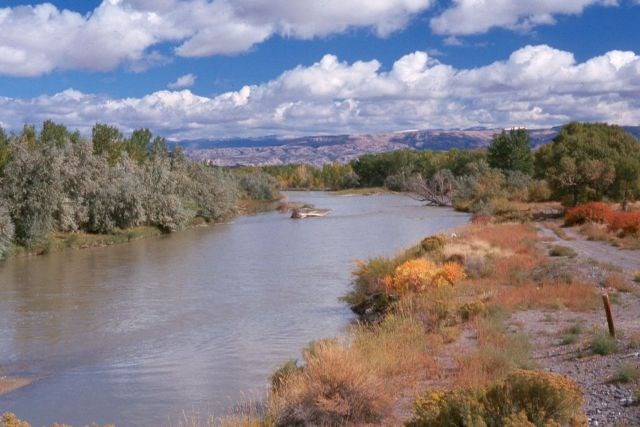Riparian Woodland
The Riparian Woodland is found along the Bighorn River. below the Afterbay Dam and south of the Mason Lovell Ranch in the southern end of the recreation area, as well as along the Shoshone River where it enters Bighorn Lake. The areas along Trail Creek and Layout Creek are also riparian in nature but not as dominated by the Eastern Cottonwood as the other areas.
Characteristics
The flowing water modifies the climate through cooler temperatures. This is because the trees that are able to grow because of the water’s presence provide shade. The river is a much more dependable water source than rainfall. The riparian areas are between 3,000 and 5,000 feet in elevation.
Eastern Cottonwood
The Eastern Cottonwood (Populus deltoids) is the most prominent deciduous tree along the rivers and grows to a hundred feet tall or more. The massive trunk often forks into stout branches and the crown is broad and open and the branches may end up slightly drooping.
The bark is silvery-white, smooth or lightly cracked when the tree is young, but becomes dark gray and deeply fissured on older trees. The leaves are 3-6” long and 4-5” wide and a deltoid (triangular) shape with a flat base and a pointed tip. The leaf margin is very coarsely toothed. The stem is flat and thus the leaf has a tendency to shake or quiver revealing both the upper dark green surface and the paler underside.
They are bright yellow in the fall. The female catkins split open to release clouds of seeds attached to the cottony like strands. While most will live about 70 to 100 years, some will reach 300 to 400 years.
Plant And Animal Life
Willows, skunkbush sumac, clematis, chokecherry, basin wild rye, wild rose as well as water loving plants like false-soloman seal and horsetail will also be present. Basin big sagebrush will be nearby. Dame’s rocket may be thick along side streams especially where beaver have built dams.
Deer and raccoon as well as skunks can be spotted. Common flickers, Western tanagers, Lazuli buntings, and red-shafted flickers will dart from tree to tree. Look for Canada geese along with a variety of ducks along the river. In the winter look for both Bald and Golden eagles.
Invasive Species
While the river provides a rich habitat for a wide variety of plants, birds, and animals, they also provide an easy corridor for non-native species to invade. These exotics or weeds can have unwelcome consequences for the native species. Tamarix, also called salt cedar, was introduced. It was planted extensively as an ornamental and to fight soil erosion. The pinkish flowers and wispy branches may seem pretty but now efforts are being made to remove tamarix.
At the time it was not known what harmful effects we would be facing decades later. These days we are much more aware of the possible consequences of invasive species. This had directly led to the National Park Service making significant efforts to keep certain exotic species like Zebra and Quagga mussels from invading our waters.

